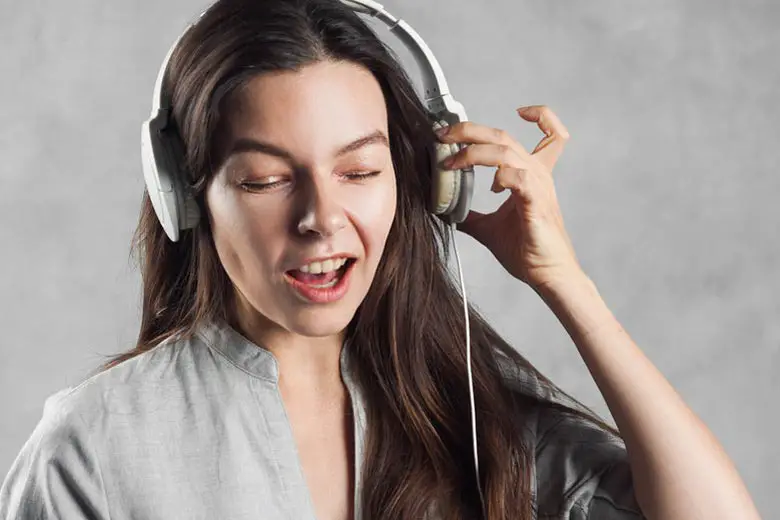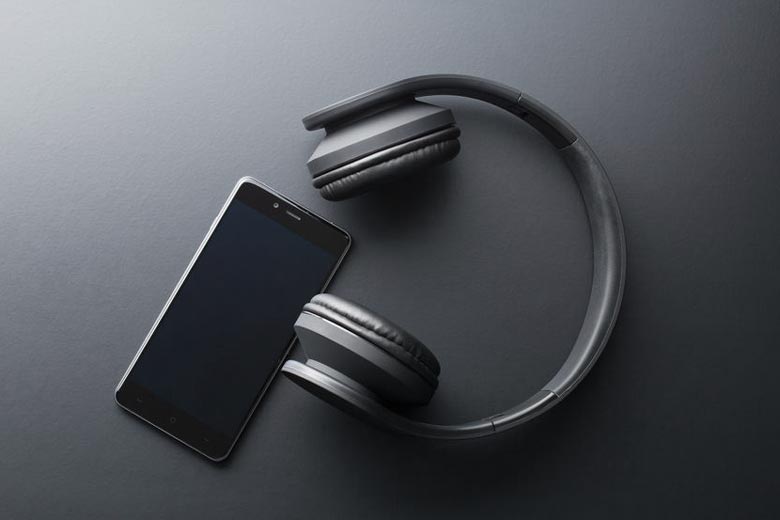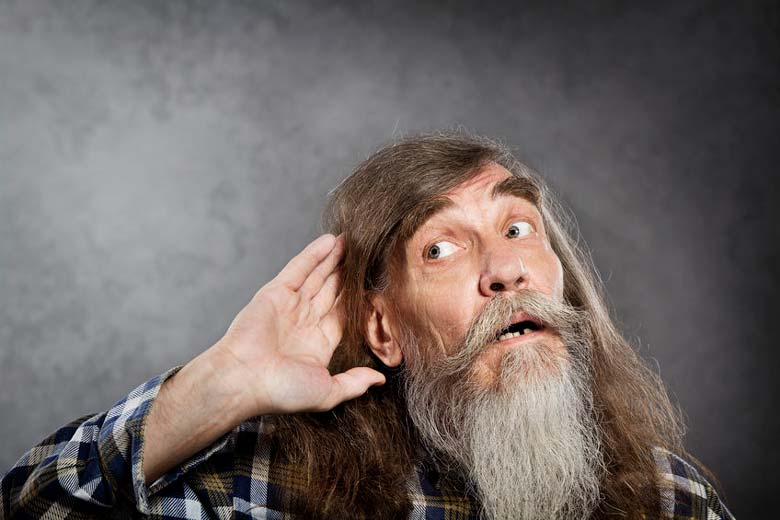Don’t let your headphones blast your ears! It’s common for some combinations of devices and headphones to be much louder than they should. However, you don’t need to spend money on another pair of cans.
Your headphones can get too loud when there’s an issue with your device’s volume settings, or the audio drivers aren’t working correctly. Common fixes include lowering system volume with an EQ, synchronizing volume across devices, and switching drivers.
Listening to your headphones at high volumes can be dangerous for your hearing. You can do several things to take care of your ears, but you can start by fixing any issues that make your headphones too loud.

1. Volume Synchronization Is Disabled
Many headphones come with their own volume settings and buttons. This can be a very helpful feature: it lets you change the volume without taking out your phone.
But this feature also brings an extra step to the process: volume synchronization.
If the volume control of your headphones and your device aren’t synchronized, you’ll need to adjust them separately.
Check for Volume Settings Across Your Apps
You might be using a program with its own volume settings, which is pumping your headphone’s volume way beyond normal.
The culprit could be:
- Audio players
- Companion apps for your headphones
- Audio/video editing software
- Companion software for your soundcard
Make the Headphones the Default Device on Windows
If you’re using Windows, you can fix this problem in most devices by selecting it as the default sound device.
- Right-click the volume icon in your tray and select “Sound.”
- Select the “Playback” tab.
- Right-click on your headphones and select “Set as Default Device.”
Turn On the Absolute Volume Setting on Android
In Android, volume synchronization is handled by the setting “Absolute Volume.” Turning it on should fix the problem.
- Turn on developer options by going to Settings, select “About phone,” and tap “Build number” several times.
- Go back to Settings and tap “Developer options.”
- Scroll down until you find “Absolute Volume” and turn it on.
2. Volume Limiters Aren’t Working Right
There are two scenarios where faulty volume limiters can be a problem:
- Your headphone’s volume limiter can’t limit their audio output to normal levels.
- You’re used to relying on software audio limiters, but your current device doesn’t have one.
Let’s take a look at the first case. Some headphones come with audio limiters. These are usually digital limiters, which are fairly effective at maintaining audio output inside a safe range.
However, the results of audio limiters can be inconsistent. Some devices, like computers and CD players, can produce very powerful outputs, which could throw off the audio limiters in your headphones.
Analog headphones can also present their own problems since analog limiters aren’t as effective as digital limiters.
On the other hand, there are also software volume limiters. These are the kind you see in smartphones. They give you exposure warnings when you’re about to go past it.
However, the default settings often leave you above safe noise levels. If that’s the case, you might want to change its settings.
Whichever is your case, activating or downloading a volume limiter in your device should fix the issue.
Set a Volume Limiter on Your Smartphone
You can set a global volume limit in your smartphone by opening Settings and going to Sound/Music.
Apple devices max out at 102db, so you should be safe by staying below 70%. Decibel outputs vary among Android phones, and some of them don’t come with a built-in audio limiter as iPhones do.
If your Android phone doesn’t come with an audio limiter, you can always download one from the PlayStore. There are plenty of options, but you won’t go wrong with VolumeLock. It’s a simple and complete app that doesn’t require any setup.
Set a Volume Limiter on a Computer
Windows has a built-in solution. It’s not very intuitive, but it doesn’t require any setup.
- Right-click on the volume icon and select “Sound.”
- Select the “Playback” tab.
- Double click on “Headphones.”
- Select the “Levels” tab.
- Click on “Balance” and reduce both sides in equal measure.
You can also try a third-party app like Quiet on the Set. It’s lightweight and easy to use.
It’s not as straightforward on a Mac, but there are some programs and custom scripts created by users that can act as volume limiters. Check out this script by Lucas Andión and the Earsafe app.
3. Audio Driver Isn’t Working
Another possible reason your headphones are too loud is your audio drivers might not be working properly. This issue is mostly present on Windows PCs.
Some audio drivers don’t properly regulate audio output when you’re using headphones. It could be a compatibility issue with your headphones or simply a problem with how the driver works.
In any case, there are two things you can do to get around this problem.
Update Driver
First, make sure your driver is updated. The developers might have already fixed the issue.
- Open the Device Manager. You can find it by clicking on the windows button and typing “device manager.”
- Expand the section called “Sound, video and game controllers.”
- Right-click on your audio driver and select “Update driver.”
Switch Drivers
If updating the driver doesn’t make a difference, you can uninstall it and stay with the stock Windows audio driver.
To do this, uninstall your audio driver from the device manager. After you restart, Windows should automatically install the default drivers for your device.
You can also download a different driver. If your PC is still using your old driver after installing the new one, do this:
- Right-click on the volume icon and select “Sound.” Go to the “Playback” tab.
- Right-click on the new driver and select “Set as default device.”
4. Lowest Volume Setting Is Too Loud
Sometimes, the fault doesn’t lie in your headphones or your device’s settings but in the OS you’re using.
Sadly, this can’t be fixed completely. The manufacturers would have to implement the fix themselves. However, there’s a way around the problem.
Download an Equalizer
Equalizers are apps that can adjust the volume of different audio frequencies that come out of your device.
EQ tools are often used to change how music sounds and optimize it for a certain genre. However, it can also boost or lower the overall volume of a device.
There are countless EQ apps for iOS, Android, Macs, and Windows PCs. Any of them should work fine.
Some EQs have sliders to adjust system volume. Otherwise, just lower all of the frequencies to the same degree.
By doing this, you’re bypassing the volume system limitations and making your device sound quieter.
5. Bluetooth Headphones Are Too Loud on Android
Some users report that their headphones only show a loudness issue when connected to an Android device. The cause of the problem is often the “Absolute Volume” setting.

We previously talked about Absolute Volume regarding volume synchronization. When turned on, it lets you synchronize volume across your Android device and your headphones.
However, this setting can also make some Bluetooth audio devices sound excessively loud.
Turn Off Absolute Volume
If you have this problem, turning off Absolute Volume should fix it.
- After turning on developer options, go to Settings and tap “Developer options.”
- Scroll down until you find “Absolute Volume” and turn it off.
Related article: 7 Common Headphone Problems and How To Fix Them
How To Know if Your Headphones Are Too Loud
Exposure to very loud noises can damage your hearing, and this also applies when it comes to headphones.
Here are a few signs your headphones are too loud:
- The sound of your headphones can be heard at arm’s length.
- You hear a ringing when you’re in quiet places.
- You’re always having to turn up the volume.
- A sound meter app measures your volume at over 85 decibels.
- Your volume is always over two-thirds.
To prevent hearing loss, you shouldn’t expose yourself to sounds louder than 85 decibels. To give you an idea: a whisper is 30 dB, a normal conversation is 60 dB, busy traffic from inside the car is 80-85 dB, and standing beside a siren is 120 dB.
So, why can’t volume limiters just set a limit on decibels? Well, your phone can’t easily measure the decibels of the sounds that come out of it.
The volume of a song depends on several things:
- How it was mixed
- Volume settings in the app you’re using
- The headphone’s volume settings (when it applies)
- The soundcard in your device
On top of all that, it’s easy to forget about volume when you’re listening to music. You might turn up the volume without realizing it when you get lost in one of your favorite songs.
So, how can you know if your headphones are being too loud on your ears? You can try doing some of the following.
Hold Your Headphones in Front of You
An easy way to know if your headphones are too loud is to hear them at a distance.
Play music at your usual volume with your headphones plugged in and hold them in front of you at arm’s length. If you can clearly hear what’s sounding, then the volume is too high.
Ask Someone
It’s a good idea to get other people’s ears on the issue.
Listen to your headphones at your usual level while having a friend sitting next to you and ask them if they could hear what you were listening to.
If a person beside you can clearly hear what you’re listening to, then it’s too loud.
There’s one exception to this rule: open-ear headphones. These headphones are designed to let the sound filter through the earpiece. In all other cases, the rule applies.
Do the Ringing Test
Here’s a simple experiment that in no way substitutes a medical exam, but it can tell you if you’re listening to music at damaging volumes.
- Take a rest from using your headphones. For better results, wait a couple of days. Otherwise, let at least three hours pass.
- Find a quiet room and listen for ringing in your ears. It’ll be easier to notice if you put on earplugs. You might have to wait a minute.
- Listen to your headphones. Set them at your usual volume and use them for what feels like a normal period for you.
- Repeat step 2. Has the ringing gotten any stronger? Do you hear a ringing that you didn’t hear before? If so, you should turn down the volume when using your headphones.
If you hear a ringing in normal circumstances, you should definitely lower the volume of your headphones and get your ears checked with a doctor.
Use an App
Apps like Sound Meter for Android let you measure decibel levels using the microphone in your smartphone or laptop. There are plenty of options for iOS and PCs.
A more sophisticated option is the NIOSH Sound Level Meter App, developed by acoustics engineers and hearing loss experts. It’s only available in the AppStore.
However, an accurate measurement would require a specialized device and some idea about what you’re doing. Use these apps as a reference together with other methods.
Check for Symptoms of Hearing Loss
If you’re already experiencing hearing loss, your headphones might be one of the culprits.

Here are some signs that will let you detect it early and prevent damage as much as possible:
- You have trouble hearing high-pitched sounds.
- You’re increasingly having to turn on the volume for your music.
- You feel ringing or clicking in your ears.
- You have trouble understanding conversations in noisy places.
- You’re very sensitive to certain sounds.
If you experience any or several of these issues, you should make an appointment with a doctor.
Read more: Can Headphones Cause Hearing Loss?
Your Volume Is Always Over 60%
This might sound obvious, but you shouldn’t turn your volume all the way up. Headphones can reach 110 dB when turned to maximum volume. This is way beyond the 85 dB safety threshold.
Experts recommend that you should keep the volume control below two-thirds. If you’re constantly increasing it beyond 60%, you’re risking yourself to hearing damage.
You Turn Up Your Volume in Noisy Areas
Being in a loud place is one of the main reasons we turn up the volume of our headphones. If there’s too much noise around you, you’ll need more volume to be able to hear your headphones.
There’s a way you can circumvent this problem: using noise-canceling or noise-isolating headphones.
- Noise-canceling headphones have tiny microphones that pick up the sounds going on around you. Then they create out-of-phase sound waves that neutralize outside sound. The result is that even the noisiest places can turn into a low hum. If you don’t hear outside noise, there’s no need to turn up the volume more than necessary.
- Noise isolation is simpler but can still make a big difference. A headphone with good isolation has ear cups that softly tighten around your ears and physically block outside noise from entering.
Also Read: 9 Safest Headphones for Your Ears: Buyer’s Guide
You Listen for Extended Periods
If you’re at a low volume, you’ll be fine listening for extended periods. However, the higher the volume, the more important it is to give your ears a break.
Listening at 80-85 dB can cause hearing damage in under 2 hours. If you go beyond that, it could be a matter of minutes before experiencing hearing loss.
If you find yourself listening to music at high volumes, rest your ears for a while before continuing. Try to turn down your usual volume when listening for extended periods.
Final Thoughts
If you feel your headphones are too loud, take the chance to make sure that your listening habits don’t put your hearing at risk.
As a rule of thumb, keep your volume under two-thirds and make sure your headphones aren’t loud enough to be heard by someone sitting beside you.
Several things can make headphones sound louder than they should, such as:
- A lack of volume synchronization
- Faulty audio drivers
- How your OS is programmed